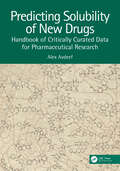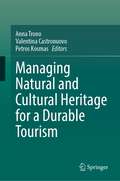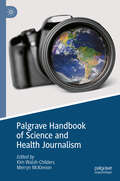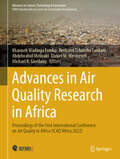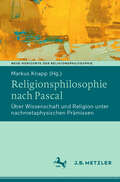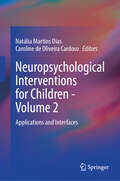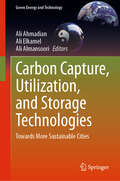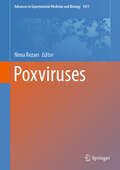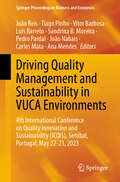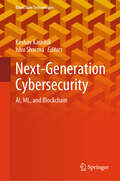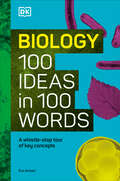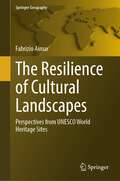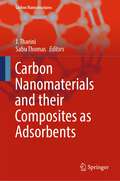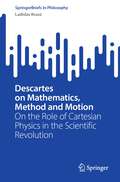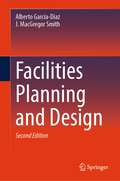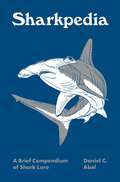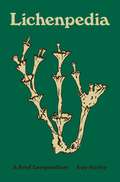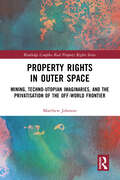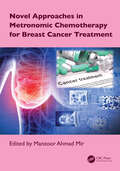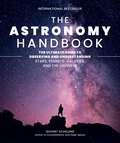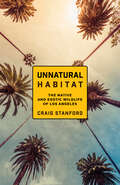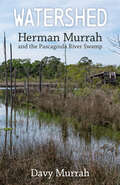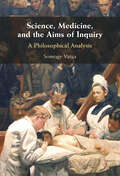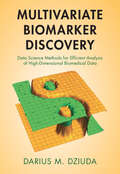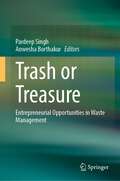- Table View
- List View
Predicting Solubility of New Drugs: Handbook of Critically Curated Data for Pharmaceutical Research
by Alex AvdeefIn pharmaceutical research, solubility plays a key part in the assessment of pharmacokinetic risks. Poor drug absorption, reduced efficacy, excessive metabolism, and adverse reactions are frequently related to issues of drug solubility. During early discovery research at pharmaceutical companies, many thousands of molecules are considered. Most are rejected due to perceived unfavorable properties. Here the author uses the Wiki-pS0TM database, which forms the backbone of this unique handbook. Also discussed is the emerging class of therapeutically promising research molecules called PROTACs (proteolysis-targeting chimeras), showing a propensity for ‘undruggable’ targets.FEATURES• A comprehensive and unique listing of measured aqueous intrinsic solubility focusing on drug-like and drug-relevant molecules.• The database can be used to predict the solubility of research pharmaceutical molecules.• Includes downloadable files of the database (.csv format).• The mining of the database can result in a better design of solubility assay protocols, leading to better quality of measurements.• Artificial intelligence and Bayesian statistics will likely be key to this subject area in the future.Alex Avdeef has been an American Association of Pharmaceutical Scientists (AAPS) Fellow since 2014, a former visiting senior research fellow at King’s College London, and is the author of Absorption and Drug Development (2nd ed., Wiley, 2012). In 2021, the book was translated into Chinese, by translators affiliated with the China Food and Drug Administration. For nearly 50 years, he has been teaching, researching, and developing methods, instruments, and analysis software for the measurement of ionization constants, solubility, dissolution, and permeability of drugs. His accomplishments in the development of instrumentation include several well-known instruments that are or recently have been manufactured by leading companies in the instrument market, including Thermo Fisher Scientific, Sirius Analytical, and Pion Inc. He has over 200 technical publications in primary scientific journals and book chapters. He has written several comprehensive technical guides and is a co-inventor on six patents. He cofounded Sirius Analytical (UK) in 1989, pION Inc. (USA) in 1996, and founded in–ADME Research (New York City) in 2011. His other positions were at Orion Research, Syracuse University, UC Berkeley, and Caltech.
Managing Natural and Cultural Heritage for a Durable Tourism
by Anna Trono Valentina Castronuovo Petros KosmasThis contributed volume offers a wealth of cases that explore the factors and conditions required for heritage tourism to be economically and socially beneficial to local communities without impairing the natural environment, cultural heritage preservation, or sustainability for future generations. The studies presented here comprise an examination of measures which have been and can be implemented to ensure sustainable use of natural and cultural systems, leading to a new concept of tourism that incorporates science and community practices together to create a favorable environment where tourists and locals can experience meaningful interactions and experiences. The book focuses on the role of stakeholders in the development of a new policy regarding the sustainable management of cultural tourism and the possibility of their involvement in the processes governing policy-making. Emphasis is placed on the role and commitment of local and international authorities, including UNESCO, in preserving the world's endangered cultural and natural heritage, as well as the responsibilities of Member States and public and private actors with respect to future conservation challenges.
Palgrave Handbook of Science and Health Journalism
by Kim Walsh-Childers Merryn McKinnonThis handbook reviews the extant literature on the most important issues in health and science journalism, with a focus on summarizing the relevant research and identifying key questions that are yet to be answered. It explores challenges and best practices in health and science reporting, formats and audiences, key topics such as climate change, pandemics and space science, and the ethics and political impacts of science and health journalist practice. With numerous international contributions, it provides a comprehensive overview of an emerging area of journalism studies and science communication.
Advances in Air Quality Research in Africa: Proceedings of the First International Conference on Air Quality in Africa (ICAQ'Africa 2022) (Advances in Science, Technology & Innovation)
by Abdelwahid Mellouki Khanneh Wadinga Fomba Bertrand Tchanche Fankam Daniel M. Westervelt Michael R. GiordanoThis book presents the recent findings on air quality in Africa from the virtual event of the first International Conference on Air Quality in Africa (ICAQ 2022), providing a comprehensive overview on many subjects of air pollution that affect African society. It highlights research progress in the chemical and physical characterization of air pollutants, their related respiratory and non-respiratory health effects, measurements and monitoring of air pollutants using satellite remote sensing and modeling techniques, currently implemented abatement policies in different African countries, existing research and networking infrastructures, and novel tools for monitoring air quality. The advances in the development of local cost-effective air quality monitoring tools in Africa as well as the use of low-cost sensors in quantifying air quality levels are presented. This book is an enrichment for researchers, experts, and advocates of air quality, atmospheric chemistry and physics, satellite remote sensing applications, and policymakers in Africa.
Religionsphilosophie nach Pascal: Über Wissenschaft und Religion unter nachmetaphysischen Prämissen (Neue Horizonte der Religionsphilosophie)
by Markus KnappIn der Formierungsphase der Neuzeit hat Blaise Pascal den durch den Fortschritt der Wissenschaften verursachten Wandel des Weltbildes sowohl existentiell erlitten wie kritisch reflektiert. Das zentrale Anliegen Pascals, der selbst ein bedeutender Wissenschaftler war, bestand darin, eine Vernunftkonzeption zu entwickeln, die der Wissenschaft ebenso wie dem religiösen Glauben Raum gibt. In den Beiträgen dieses Bandes der Reihe Neue Horizonte der Religionsphilosophie wird zum einen das Projekt Pascals im Kontext des 17. Jahrhunderts hermeneutisch erschlossen. Zum anderen wird systematisch reflektiert, welche Bedeutung ihm in den gegenwärtigen Kontroversen um ein gemessenes Verhältnis von Vernunft und Religion, Gott und Säkularität zukommen kann.
Neuropsychological Interventions for Children - Volume 2: Applications and Interfaces
by Caroline de Oliveira Cardoso Natália Martins DiasThis book is the second of two volumes that aim to serve as a comprehensive guide for professionals working with neuropsychological interventions especially designed for children. This second volume complements the theoretical and practical foundations presented in the first volume by presenting applications to different clinical conditions and by exploring interfaces of neuropsychology with other areas of research and practice. Chapters in this second volume are divided into two parts. The first part presents a series of case studies, illustrating the practice and experience of neuropsychological rehabilitation and habilitation in different clinical conditions. The second part brings together chapters that discuss the interfaces of neuropsychology with different areas, which can use its knowledge and interventions (such as school neuropsychology) or which can be used as strategies within neuropsychological intervention or even compose inter and transdisciplinary partnerships in the work of promotion, stimulation, or cognitive remediation, such as the use and role of music, games and play, mindfulness, and transcranial direct current stimulation. So, chapters in this second part highlight the interfaces with other approaches, knowledges or disciplines. Originally published in Portuguese and now available in English, Neuropsychological Interventions for Children – Volumes 1 and 2 will be of interest to professionals working with neuropsychology in clinical and school contexts. It will also be useful in neuropsychology teaching contexts (specialization courses in neuropsychology and related areas) and for students and professionals in interface areas, such as Psychology, Education, Speech Therapy, Occupational Therapy among others. The translation of the original Portuguese version of this book into English was done with the help of artificial intelligence. A subsequent human revision was done primarily in terms of content.
Carbon Capture, Utilization, and Storage Technologies: Towards More Sustainable Cities (Green Energy and Technology)
by Ali Elkamel Ali Ahmadian Ali AlmansooriThis book brings together cross-disciplinary research on carbon capture, utilization, and storage (CCUS) to examine the impact of implementing CCUS tools and technologies on emissions reduction and sustainable development in cities and large metropolitan areas. An expert group of global contributors provides in-depth technical discussions, case studies, and examples with an emphasis on the worldwide application of the latest developments in technology, protocols, implementation, and application of CCUS in power and energy systems.Carbon Capture, Utilization, and Storage Technologies: Towards More Sustainable Cities is an essential multidisciplinary reference for researchers and industry practitioners from engineering, energy, computer science, data science, economics, and operational research working in the energy and environmental fields.
Poxviruses (Advances in Experimental Medicine and Biology #1451)
by Nima RezaeiSince the emergence of 2022’s monkeypox virus (MPXV) outbreak, it has been the heading of news and research articles that MPXV is being involving non-endemic areas after about its 80-year presence in endemic areas. Efforts are concentrated on understanding how MPXV has evolved to cause an epidemic. The book provides a comprehensive compendium of chapters on poxviruses in different domains. It concludes that the main problem we should deal with is not to address how MPXV has overcome the distance between non-endemic and endemic areas, but it is the non-cooperativity of logistics, research, and science in managing poxviruses’ outbreaks.
Driving Quality Management and Sustainability in VUCA Environments: 4th International Conference on Quality Innovation and Sustainability (ICQIS), Setubal, Portugal, May 22-23, 2023 (Springer Proceedings in Business and Economics)
by João Reis Tiago Pinho Vítor Barbosa Luís Barreto Sandrina B. Moreira Pedro Pardal João Nabais Carlos Mata Ana MendesThis proceedings volume provides in-depth research in the fields of quality innovation, sustainability, and operations management. It features contributions from the 4th International Conference on Quality Innovation and Sustainability (ICQIS) that explore how research in quality and innovation boost sustainability and includes solutions to complex industrial problems presented by researchers, professionals, and managers in the field. It also examines the drivers of quality management and sustainability in VUCA environments, with a special focus on supply chain management and innovation. Featuring real business cases on quality and sustainability, this book is useful for researchers, scholars, students, and academics interested in quality management, supply chain management, circular economy, and sustainability.
Next-Generation Cybersecurity: AI, ML, and Blockchain (Blockchain Technologies)
by Keshav Kaushik Ishu SharmaThis book highlights a comprehensive overview of the recent advancements and challenges in the field of cybersecurity with a focus on the integration of artificial intelligence (AI), machine learning (ML), and blockchain technologies. The book targets both researchers and practitioners working in the field of cybersecurity and aims to fill the gap in the current literature by providing a comprehensive and up-to-date examination of the integration of AI, ML, and blockchain in cybersecurity systems. The book has a technical focus and provides an in-depthexamination of the latest developments in the field. It covers a range of topics including the basics of AI, ML, and blockchain, the application of AI and ML in cybersecurity, the use of blockchain in cybersecurity, and the integrationof AI, ML, and blockchain in cybersecurity systems. Each chapter is written by leading experts in the field and provides a thorough and technical overview of the topic, including case studies, examples, and practical applications.
Biology 100 Ideas in 100 Words: A Whistle-stop Tour of Science’s Key Concepts
by Eva AmsenBiology Ideas in 100 Words offers the essential facts at your fingertips, satisfying your scientific curiosity and helping you to understand the biggest concepts in biology in concise, 100-word summaries.One of the titles in a cutting-edge new series created in partnership with The Science Museum, this book introduces 100 key areas of biology-such as life processes, evolution, DNA and inheritance, diversity of plants, immunity, and disease-and explains each topic in just 100 words. Perfect for getting your head around big ideas clearly and quickly or refreshing your memory of the fundamentals of life on earth, this book covers the most up-to-date terms and theories and inspires a heightened level of understanding and enjoyment to the core areas of biology explored in The Science Museum.
The Resilience of Cultural Landscapes: Perspectives from UNESCO World Heritage Sites (Springer Geography)
by Fabrizio AimarThis book explores the possibility of building the resilience of the UNESCO cultural landscapes, both using theoretical conceptions and practical strategies and actions. Two case studies have been selected, one in Italy and one in China, which have then been explored for the first time in such a comparative way. Different notions of landscape, as well as the driving force of changes affecting these landscapes, are examined and compared. Moreover, the perceptions of the local communities regarding these landscapes are examined, using online questionnaires with over 400 participants. This research highlights the need for an integrated management system, building stronger rural communities able to manage change and continuity. Five pillars to build the resilience of these landscapes have been provided, with schemes and figures, requiring a people-centered approach in their management. This book demonstrates strong connections between identity and landscape resilience, especially in inlandareas where the sense of identity is most prominent. Furthermore, it is structured to make it possible to replicate this investigation in ordinary case studies, i.e. ordinary landscapes. Scholars and professionals interested in cultural landscapes and heritage conservation are target of this book, as well as site managers.
Carbon Nanomaterials and their Composites as Adsorbents (Carbon Nanostructures)
by Sabu Thomas J. ThariniThis book elucidates fundamental concepts of nanomaterials and their pivotal role as nanoadsorbents in water purification. Key features include the latest trends in adsorption for metal, micro pollutants, food adulterants, aromatic compounds, pesticides, dyes, and oil particle removal. Additionally, the interdisciplinary aspects of adsorption and practical applications for hazardous chemical removal from water are explored. The book delves into various types of adsorption isotherms such as Langmuir, Freundlich, BET, and others, offering a deep understanding for water purification. Kinetic models including first, second, and third order kinetics are elucidated, empowering undergraduate students to grasp and optimize complex systems. The required background is basic knowledge in chemistry, biology, mathematics, and nanoscience at the first-year university level. Designed for both academics and industrial researchers, this book is divided into 17 chapters. Chapters 1-7 introduce nanomaterials, carbon nanoadsorbents, their synthesis, and surface modification. Chapters 8-9 cover fundamental adsorption isotherms, kinetic models, thermodynamic parameters, adsorption mechanism, and experimental techniques. Chapters 10-15 delve into the adsorption and desorption of various compounds like aromatic compounds, pesticides, heavy metals, micro pollutants, food adulterants, oil particles, and dyes molecules. The final chapter tackles the theoretical modeling of carbon nanomaterials for adsorption studies
Descartes on Mathematics, Method and Motion: On the Role of Cartesian Physics in the Scientific Revolution (SpringerBriefs in Philosophy)
by Ladislav KvaszThis book argues that Descartes’ physics was a milestone on the road to modern mathematical physics. After Newton introduced a completely different approach to mathematical description of motion, Descartes’ physics became obsolete and even difficult to comprehend. This text follows the language of Descartes and the means of which motion can be described. It argues that Descartes achieved almost everything that later Newton was able to do—to describe the motion of interacting bodies- by different (i.e. algebraic) means. This volume completely refutes the received view according to which Descartes’ physics was merely a kind of discursive natural philosophy. To make this interpretation more plausible the book follows Descartes’ ideas from his early work in mathematics, through his invention of the analytic method towards his mature physics. It shows that Descartes followed a similar heuristic pattern.The volume appeals to students and researchers; it invites the reader equippedwith minimal understanding of college mathematics to follow Descartes on his intellectual journey through the Scientific Revolution. The reader will gain a deeper understanding of the role of mathematical language in the creation of modern physics and a glimpse into the fascinating world of Descartes’ scientific thought. Several of Descartes’ philosophical ideas can be traced back to his scientific interests and thus the book elucidates the motivation behind some of Descartes’ key positions in the area of epistemology and method. In the penultimate chapter the book presents four arguments in favor of seeing Descartes as a physicist on par with Galileo and Newton.
Facilities Planning and Design
by Alberto Garcia-Diaz J. MacGregor Smith(Deceased)This updated, expanded, second edition includes new software methodologies and algorithms providing students with a more comprehensive knowledge base in addition to facilitating and making the project component of the textbook more efficient and effective. It further increases emphasis on manufacturing. Retaining its class-tested pedagogy, the book is concerned with the principles of facilities planning and their application to service, business, and product manufacturing operations. Equipping undergraduate students with the fundamentals of facilities planning, design, location and material handling, especially as they apply to industrial manufacturing facilities, the book is ideal for a range of university settings offering courses on facilities planning.
Sharkpedia: A Brief Compendium of Shark Lore (Pedia Bks. #13)
by Daniel AbelA fun, pocket-size A–Z treasury about sharks, featuring fascinating, little-known facts and captivating illustrationsSharkpedia is an entertaining and enlightening celebration of sharks featuring close to 100 entries, based on the latest knowledge and enriched by original illustrations. Avoiding tired factoids, shark authority Daniel Abel gives new bite to essential information about sharks, including their adaptations as top predators, 450-million-year evolution, behavioral complexity, ecological importance, existential threats, and often sensationalized appearances in popular culture, from Jaws to Shark Week.The notion that sharks are insatiable killing machines is a toothless myth—yet the fear of shark attacks still holds on to many people like a set of locked jaws. Sharkpedia reveals that sharks are much less to be feared—and much more interesting, complicated, and important—than many realize. Filled with compelling stories, Sharkpedia debunks shark myths (for example, that sharks are large and coastal when in fact most are small and inhabit the deep sea), describes their lives (where and how long they live, how many offspring they have, what they eat, and how their bodies function), introduces a variety of iconic and obscure species (such as the Happy Eddie Shyshark), explores our love/hate relationship with sharks, and much more.With charming drawings by leading shark artist Marc Dando, Sharkpedia is a scientific and cultural treasure trove that will leave you with new insights about these remarkable animals. Dive in!Features a cloth cover with an elaborate foil-stamped design
Lichenpedia: A Brief Compendium (Pedia Books #11)
by Kay HurleyAn illustrated mini-encyclopedia about the weird and wonderful world of lichensLichenpedia is a delightfully entertaining and beautifully illustrated A–Z treasury about the strange, obscure, and remarkable world of lichens, from their unique and essential roles in nature and the ways they are used in dyeing, brewing, and drug-making to how they have inspired writers and artists, from Henry David Thoreau to modern painters.In 100 brief entries written in a vivid, lively style, Kay Hurley introduces key aspects of lichen biology, environmental roles, emerging uses, scientific history, and myth. She describes the variety of forms that lichens take, from leafy to filamentous to things reminiscent of skin diseases, with imaginative names like witch&’s hair. She explains the surprising ways that birds and beasts—from reindeer and moose down to tiny tardigrades—use lichens, and how lichens survive in extreme environments, from deserts to Antarctica to outer space. Hurley also introduces some of the innovators who have advanced the knowledge of lichens, from the ancient Greek philosopher Theophrastus to today&’s professional lichenologists.With charming drawings by Susan Adele Edwards, Lichenpedia promises to put you in touch with the natural world in a new way by opening your eyes to these vital organisms, which are all around us, hidden in plain sight.Features a cloth cover with an elaborate foil-stamped design
Property Rights in Outer Space: Mining, Techno-Utopian Imaginaries, and the Privatisation of the Off-World Frontier (Routledge Complex Real Property Rights Series)
by Matthew JohnsonThis book explores the role of private mining rights in the utopian imaginary of space colonisation. It presents a transdisciplinary account of the new and evolving legislative frameworks that have been established in anticipation of commercial exploitation of the mineral resources of the off-world frontier. Written in an engaging style, the book investigates a novel case study in the history of capitalism and 'the commons': the emergence of a nascent space mining industry, undergirded by a contentious legislative framework. In 2015, the US passed laws that would recognise the claims of US corporations to own and sell space resources. This unilateral act of pre-emptive law-making would appear to contravene the terms of the UN Outer Space Treaty (1967), which declared that the exploration and use of outer space should be ‘for the benefit of all mankind’ and ‘not subject to national appropriation’.Using this central dynamic between privately held mining rights and outer space as a 'global commons', Matthew Johnson constructs an historical sociology of space mining – from the deep historical roots of common and private property to the contemporary networks of neoliberalism that have engaged with the commercialisation of space activity. The anticipatory expansion of private property claims beyond the Earth both resonates with and problematises the ‘terrain’ of political history, such as the tensions between states and markets, public law and private power, ‘the commons’ and exclusive property. The emerging cosmopolitics of off-world private property mirrors (and is often explicitly embedded within) neoliberal geopolitics, prompting urgent questions about how we can reaffirm principles of democracy and ‘common heritage’ in the international laws of Earth and space. This book is compelling reading for anyone interested in the social study of space, law, economics, technology, politics and property rights.
Novel Approaches in Metronomic Chemotherapy for Breast Cancer Treatment
by Manzoor Ahmad MirThis book provides the latest research and developments in the field of metronomic chemotherapy for breast cancer. It presents the principles and mechanisms of metronomic chemotherapy, preclinical and clinical studies, and the latest developments in drug delivery systems and nanoformulations. The clinical pharmacology of metronomic chemotherapy, including pharmacokinetics, pharmacogenetics, pharmacoeconomics, and adverse drug reactions, are also examined.Key Features: Introduces metronomics therapy in the neoadjuvant and adjuvant treatment of breast cancer Explores the potential of metronomics in terms of personalized chemotherapy Present pharmacological bases of metronomic chemotherapy Covers the latest developments in drug delivery systems, nanotechnology, and nanoformulations Discusses antiangiogenic effects and the impact of metronomics on immunity This book is useful for students, researchers, oncologists, pharmacologists, and healthcare experts interested in understanding the clinical potential of metronomic chemotherapy in breast cancer.
The Astronomy Handbook: The Ultimate Guide to Observing and Understanding Stars, Planets, Galaxies, and the Universe
by Govert SchillingThis essential guide for every amateur astronomer explores the entire universe in one practical, easy-to-use, beginner-friendly handbook.The Astronomy Handbook, by award-winning astronomy writer Govert Schilling, is the indispensable, go-to guide to everything you ever wanted or need to know about space, including: the stars and the constellations planets comets eclipses galaxies black holes exoplanets and much more It also offers an excellent education for every amateur astronomer, including detailed and practical information on how to: locate and track the movements of the constellations throughout the year view the planets and the cosmos select the best equipment to use, including telescopes and cameras photograph objects in space Schilling provides a fascinating history of astronomy, as well as clear and accessible explanations of binary, variable, and neutron stars; black holes and gamma-ray bursts; the formation and structure of galaxies; dark matter; and extraterrestrial life.The Astronomy Handbook is a primordial soup-to-nuts guide to the cosmos and an essential reference for every student of the universe.
Unnatural Habitat: The Native and Exotic Wildlife of Los Angeles
by Craig StanfordA guide to the ecosystem famously known as Los Angeles, from a field biologist and longtime San Gabriel Valley resident."A worthy and illuminating entry in the tradition of works exploring urbanization's effect on the environment." —Los Angeles TimesWithin the sprawling metropolis of Los Angeles and its suburbs, residents coexist—often unknowingly—with a bustling mosaic of native and introduced wildlife. Conservationist Craig Stanford, whose research has taken him around the world, now takes a deep dive into the natural history of his Southern California home. Stanford's informed and vivid accounts of more than 150 species entreat us to appreciate the ecological marvels of sagebrush and skunks and skippers, the iconic palms of LA lore, and the mountain lions still roaming the hills.These portraits of the glamorous, humble, irritating, and altogether fascinating species that live alongside Angelenos urge us to recognize that even in a jungle of concrete, we live within nature. Witty and captivating, and combining cutting-edge research with his own critter encounters, Stanford demonstrates the beauty of shaping our cities to support biodiversity, and he warns against the threats that can tip urban ecosystems out of balance, leaving us in a much lonelier world.
Watershed: Herman Murrah and the Pascagoula River Swamp
by Davy MurrahThe Pascagoula River is the largest unobstructed river in the contiguous United States. Because of this lack of restraint, the river has been left to rise and fall naturally with the seasons, overflowing annually into the adjoining bottomland forest. This phenomenon makes the Pascagoula River one of the wildest rivers, surrounded by some of the most ecologically diverse woodlands, in North America.Herman Murrah (1935–2002) lived his entire life on the banks and in the swamp surrounding this river in southeast Mississippi. Watershed: Herman Murrah and the Pascagoula River Swamp recounts pivotal moments in Herman’s life and in Mississippi’s conservation history more broadly. In this book, Herman’s eldest son, Davy, details the adventures that continue to inspire young conservationists in the fight to protect our remaining natural ecosystems.As a young adult, Herman worked as a game warden in the Pascagoula River Swamp. When the Pascagoula Hardwood Company, then owners of the swamp, decided to sell the vast tract of forest for clearcutting, Herman was incensed. Determined to protect this natural wonder, Herman teamed up with other visionaries to persuade the State of Mississippi to purchase the land and preserve it in perpetuity to the benefit of future generations of humans and wildlife alike. Eventually, the state agreed and finalized the purchase. Herman was appointed area manager for the upper portion of the newly designated Pascagoula River Wildlife Management Area. He dedicated the remainder of his life to preserving, protecting, and improving the swamp for the good of south Mississippi.
Science, Medicine, and the Aims of Inquiry: A Philosophical Analysis
by null Somogy VargaAfter its unparalleled rise and expansion over the past century, medicine is increasingly criticized both as a science and clinical practice for lacking scientific rigor, for contributing to overmedicalization, and for failing to offer patient-centered care. This criticism highlights serious challenges which indicate that the scope and societal role of medicine are likely to be altered in the 21st century. Somogy Varga's ground-breaking book offers a new perspective on the challenges, showing that they converge on fundamental philosophical questions about the nature and aim of medicine. Addressing these questions, Varga presents a philosophical examination of the norms and values constitutive of medicine and offers new perspectives on how to address the challenges that the criticism raises. His book will offer valuable input for rethinking the agenda of medical research, health care delivery, and the education of health care personnel.
Multivariate Biomarker Discovery: Data Science Methods for Efficient Analysis of High-Dimensional Biomedical Data
by null Darius M. DziudaMultivariate biomarker discovery is increasingly important in the realm of biomedical research, and is poised to become a crucial facet of personalized medicine. This will prompt the demand for a myriad of novel biomarkers representing distinct 'omic' biosignatures, allowing selection and tailoring treatments to the various individual characteristics of a particular patient. This concise and self-contained book covers all aspects of predictive modeling for biomarker discovery based on high-dimensional data, as well as modern data science methods for identification of parsimonious and robust multivariate biomarkers for medical diagnosis, prognosis, and personalized medicine. It provides a detailed description of state-of-the-art methods for parallel multivariate feature selection and supervised learning algorithms for regression and classification, as well as methods for proper validation of multivariate biomarkers and predictive models implementing them. This is an invaluable resource for scientists and students interested in bioinformatics, data science, and related areas.
Trash or Treasure: Entrepreneurial Opportunities in Waste Management
by Pardeep Singh Anwesha BorthakurIn this book, we have contributions from experts working on diverse aspects of waste management and waste entrepreneurship with an aim to contribute toward a holistic understanding of the existing and forthcoming waste handling challenges. Waste entrepreneurship refers to the practice of creating and operating businesses that aim to address the problem of waste management. It signifies businesses that are dedicated to finding innovative solutions for managing waste and plays a crucial role in building a sustainable future. Waste entrepreneurs identify waste as a valuable resource and use state-of-the-art tactics to reduce, reuse, recycle, and re-purpose it. By developing new technologies, services, and products that help reduce waste and recycle materials, they can create new economic opportunities while simultaneously reducing the environmental impact of waste. The primary audience of this book are researchers (from a wide range of disciplinary backgrounds) working in the field of waste management (especially E-waste, Plastics, Paper and Cardboard Waste, Organic Waste, and Construction and Demolition Waste) and environmental sustainability. This book also contains descriptions of various facets of waste entrepreneurship from different countries which will be helpful for different entrepreneurs looking for business opportunities in the waste management sector, NGOs, government agencies, international agencies, and new researchers working in the related fields. In particular, the book could provide start-up ideas to the enthusiastic readers.
